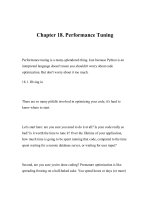Chapter 18 potx
Bạn đang xem bản rút gọn của tài liệu. Xem và tải ngay bản đầy đủ của tài liệu tại đây (432.92 KB, 55 trang )
© 2008 Pearson Prentice Hall, Electronic Commerce 2008, Efraim Turban, et al.
Chapter 18
Social Networks
and Industry Disruptors
in the Web 2.0 Environment
18-2
Learning Objectives
1. Understand the Web 2.0 revolution, social and
business networks and industry and market
disruptors.
2. Describe Google and the search engine industry, the
impact on advertisement, and the industry
competition.
3. Understand the concept, structure, types and issues
of virtual communities.
4. Understand the social and business networks and
describe MySpace, Flicker, Facebook, CyWorld, and
other amazing sites.
18-3
Learning Objectives
5. Understand the person-to-person video
sharing and describe YouTube and its
competitors.
6. Describe business networks.
7. Describe why the travel and hospitality
industry is moving so rapidly to Web
2.0.
8. Describe the concept of P2P landing
and the story of ZOPA, and Prosper.
18-4
Learning Objectives
9. Describe how the entertainment industry
operated in the Web 2.0 environment.
10. Describe some of the enablers of the Web
2.0 revolution: blogging, wikis, mushups, etc.
11. Understand the financial viability that
accompanies digital Web 2.0
implementation.
12. Describe the anticipated future of EC and the
Web 3.0 concept.
18-5
The Web 2.0 Revolution, Social Networks,
Innovations, and Industry Disruptors
Web 2.0
The popular term for advanced Internet
technology and applications including blogs,
wikis, RSS, and social bookmarking. Web 2.0
offers greater collaboration among Internet
users and other users, content providers, and
enterprises than Web 1.0
Foundation of Web 2.0
The Web as a democratic, personal, and do-it-
yourself medium of communications
18-6
The Web 2.0 Revolution, Social Networks,
Innovations, and Industry Disruptors
Representative Characteristics of Web 2.0
The ability to tap into the collective intelligence of
users
Making data available in new or never-intended
ways
The presence of lightweight programming
techniques and tools that let nearly anyone act as a
developer
The virtual elimination of software-upgrade cycles
by making everything a perpetual beta or work in
progress, and by allowing rapid prototyping using
the Web as a platform
18-7
The Web 2.0 Revolution, Social Networks,
Innovations, and Industry Disruptors
Users own the data on the site and exercise
control over that data
An architecture of participation and digital
democracy that encourages users to add
value to the application as they use it
The creation of new business models
A rich interactive, user-friendly interface
based on Ajax or similar frameworks
18-8
The Web 2.0 Revolution, Social Networks,
Innovations, and Industry Disruptors
social media
The online platforms and tools that
people use to share opinions,
experiences, including photos, videos,
music, insights and perceptions with
each other
18-9
The Web 2.0 Revolution, Social Networks,
Innovations, and Industry Disruptors
Ground rules of social media:
1. Communication in the form of
conversation, not monologue
2. Participants in social media are people,
not organizations
3. Honesty and transparency are core values
4. It’s all about pull, not push
5. Distribution instead of centralization
18-10
The Web 2.0 Revolution, Social Networks,
Innovations, and Industry Disruptors
18-11
The Web 2.0 Revolution, Social Networks,
Innovations, and Industry Disruptors
Industry and Market Disruptors
disruptors
Companies that introduce a significant change in
their industries thus cause disruption in the way
business is done
Checklist of questions to help identify disruptors
1. Is the service or product simpler, cheaper, or more
accessible?
2. Does the disruptor change the basis of competition with
the current suppliers?
3. Does the disruptor have a different business model?
4. Does the product or service fit with what customers
value and pay for?
18-12
The Web 2.0 Revolution, Social Networks,
Innovations, and Industry Disruptors
The top four killers of would-be-
disruptors:
1. Is the disruptor trying to be beat the
mainstream supplier at his own game?
2. Is the disruptor choosing growth ahead of
profits?
3. Does the disruptor need to change consumer
behavior or to ‘educate’ the customer?
4. Is the disruptor saddled with old business
processes or an outdated business model?
18-13
The Web 2.0 Revolution, Social Networks,
Innovations, and Industry Disruptors
The potential for disruption and
opportunity
The best future companies are likely those that
will create innovative new ways to facilitate
collaboration by the hundreds of millions of us
who can be reached and embraced by
effective architectures of participation
The big winners will enable us and encourage
us to take control, contribute, shape, and direct
the designs of the products and services that
we in turn consume
18-14
The Web 2.0 Revolution, Social Networks,
Innovations, and Industry Disruptors
18-15
Google and Company:
Advertisement and Search Engines
search engine
A document retrieval system designed to help find
information stored on a computer system, such as
on the web, inside a corporate in proprietary files, or
in a personal computer. Search can be conducted
from some cell phones as well
How Do Search Engines Work?
Search engines perform three basic tasks:
1. They keep an index of words they find, and where they find
them
2. They allow users to look for words or combinations of words
found in that index
3. They search the Internet based on key words
18-16
Google and Company:
Advertisement and Search Engines
Search Wars: Google versus Yahoo
and Others
The Web search world changed in 1998 when
Google introduced link popularity—counting the
number of links and importance of those links—
in its search algorithm
Yahoo! Search is an Internet portal
Amazon’s a9.com is a search engine with
memory
Microsoft’s MSN Search
18-17
Google and Company:
Advertisement and Search Engines
Froogle
Google Catalogs
Google News
Google Earth
Google maps
Google maps for
mobile
Google Scholar
Google Wireless
Google Groups
Google Print
GMail
Google Mini
Google Desktop
Orkut (social
networking)
How Does Google Compete?
18-18
Google and Company:
Advertisement and Search Engines
Answer-Based Search Engines
Google discontinued its answer-based
search in November 2006
Disruptors of Google, Will They
Succeed?
Intelligent search engine
Wikia.com and collaborative innovation
18-19
Virtual Communities
Virtual (Internet) community
A group of people with similar interests who
interact with one another using the Internet
Examples of Communities
Associations
Ethnic communities
Gender communities
Affinity portals
Catering to young people
Mega communities
B2B online communities
Social networks
18-20
Virtual Communities
Types of Communities
Transaction and other
business
Purpose or interest
Relations or practice
Fantasy
Social networks
10 important trends within
online communities:
Search communities
Trading communities
Education communities
Scheduled events
communities
Subscriber-based communities
Community consulting firms
E-mail-based communities
Advocacy communities
CRM communities
Mergers and acquisitions
activities
18-21
Virtual Communities
Commercial Aspects of Communities
Understand a particular niche industry
Build a site that provides the information necessary to
that niche
Set up the site to mirror the steps a user goes through
in the information-gathering and decision-making
process
Build a community that relies on the site for decision
support
Start selling products and services that fit into the
decision-support process
18-22
Virtual Communities
Key Strategies for Successful Online Communities
1. Increase traffic and participation in the community
2. Focus on the needs of the members; use facilitators
and coordinators
3. Encourage free sharing of opinions and information
—no controls
4. Obtain financial sponsorship
5. Consider the cultural environment
6. Provide several tools and activities for member use;
communities are not just discussion groups
7. Involve community members in activities and
recruiting
8. Guide discussions, provoke controversy, and raise
sticky issues
18-23
Virtual Communities
Six more success factors
1. Handle member data sensitively
2. Maintain stability of the Web site with respect to the
consistency of content, services, and types of
information offered
3. Provide fast reaction time of the Web site
4. Offer up-to-date content
5. Offer continuous community control with regard to
member satisfaction
6. Establish codes of behavior (netiquette/guidelines)
to contain conflict potential
18-24
Online Social Networks
social network
A special structure made of individuals (or
organizations). It includes the ways in which
individuals are connected through various
social familiarities
social network analysis
The mapping and measuring of relationships
and flows between people, groups,
organizations, animals, computers or other
information/knowledge processing entities
18-25
YouTube & Company:
A Whole New World
YouTube: The Essentials
YouTube is a consumer media company where
people can watch and share original videos worldwide
through a Web experience
On YouTube people can:
Upload, tag, and share videos worldwide
Browse millions of original videos uploaded by community
members
Find, join, and create video groups to connect with people
who have similar interests
Customize the experience by subscribing to member videos,
saving favorites, and creating playlists
Integrate YouTube videos on Web sites using video embeds
or APIs
Make videos public or private









